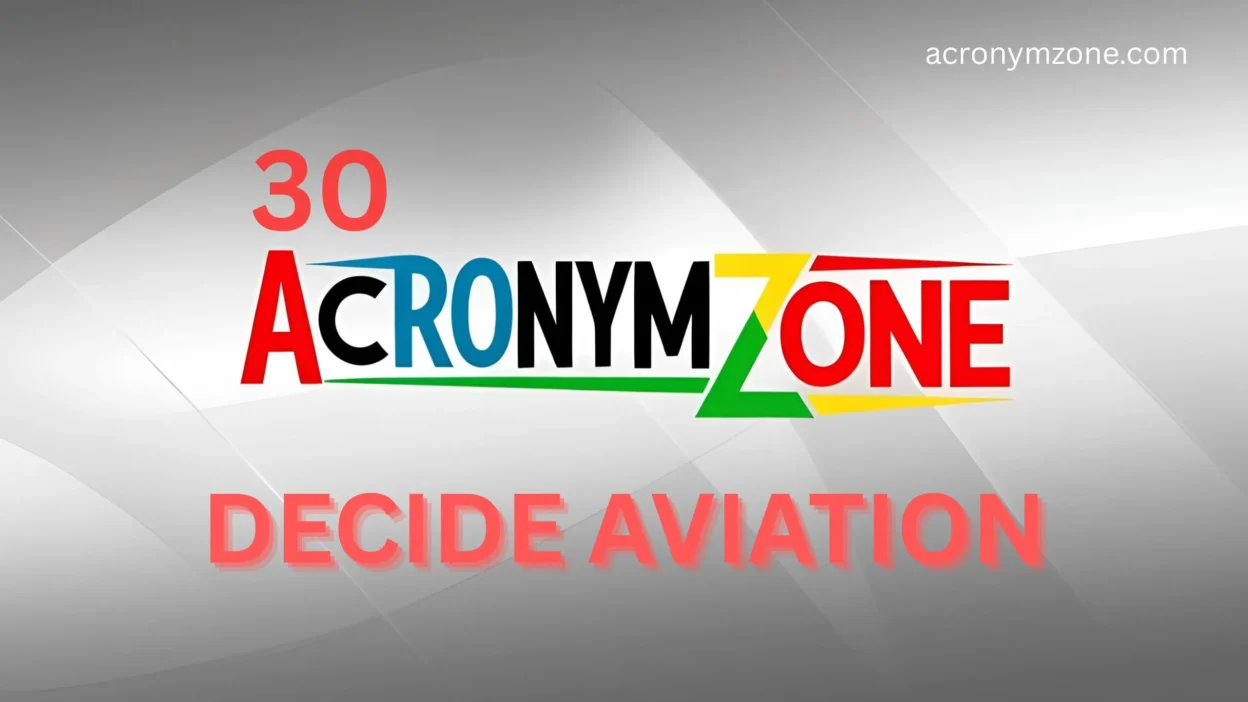If you’ve ever taken flight training or studied aviation safety, chances are you’ve come across the DECIDE acronym. It’s one of the most widely respected decision-making models in aviation, especially during emergencies or complex in-flight scenarios.
But what if you’re looking for alternative acronyms—either for teaching, training variation, or simply enriching your understanding?
In this article, we’ll break down the core meaning and traits of “DECIDE acronym aviation,” then provide 30 alternative acronyms or mnemonic-style models that capture the essence of DECIDE. We’ll also explain when to use each alternative, how their tone or focus might differ, and how to apply them to real-world situations.
🛩️ What is the DECIDE Acronym in Aviation?
The DECIDE model is used by pilots and aviation professionals to guide systematic, thoughtful decision-making under pressure.
Here’s what it stands for:
- Detect the problem
- Estimate the need to react
- Choose a course of action
- Identify solutions
- Do the necessary action
- Evaluate the effect
At its core, the DECIDE acronym promotes structured thinking, calm under stress, and proactive judgment—traits that are essential not just in the cockpit, but in any high-stakes situation.
💡 30 Alternative Acronyms for “DECIDE Acronym Aviation” (with Practical Usage)
Below are 30 creative and relevant alternatives to the DECIDE model. While some are aviation-specific, others adapt the spirit of DECIDE for broader problem-solving and emergency responses.
Each one includes a short explanation, a situation where it’s best used, and an example sentence.
1. OODA (Observe, Orient, Decide, Act)
Used by fighter pilots for fast, tactical decisions.
Use when decisions must be made rapidly in changing environments.
“She ran through her OODA loop before executing the turn.”
2. SHELL (Software, Hardware, Environment, Liveware)
Used for human factors analysis.
Use in training and system design contexts.
“We applied the SHELL model to improve cockpit ergonomics.”
3. IMSAFE (Illness, Medication, Stress, Alcohol, Fatigue, Emotion)
Used for pilot self-assessment before flight.
Use for personal readiness checks.
“Before takeoff, I ran through IMSAFE to ensure I was fit to fly.”
4. PAVE (Pilot, Aircraft, enVironment, External pressures)
Evaluates risk factors.
Use in pre-flight risk management.
“Using PAVE helped us decide whether to delay the flight.”
5. TEAM (Transfer, Eliminate, Accept, Mitigate)
Used for managing identified risks.
Use in post-risk assessment decisions.
“We chose to mitigate the engine vibration using TEAM.”
6. GOLD (Gather, Organize, Lead, Decide)
Decision-making in group settings.
Use for crew resource management.
“The captain used GOLD during the in-flight emergency.”
7. SAFECOM (Safety Communication)
Framework for incident reporting.
Use in safety documentation and learning.
“Filing a SAFECOM raised awareness of the hazard.”
8. FORDEC (Facts, Options, Risks & Benefits, Decision, Execution, Check)
European alternative to DECIDE.
Use when structured thinking is required.
“She applied the FORDEC model mid-flight to resolve the issue.”
9. NITS (Nature, Intentions, Time, Special Instructions)
Used in emergency briefings.
Use for rapid cockpit communication.
“The first officer gave a NITS briefing after engine failure.”
10. TAR (Threat, Action, Result)
Simple situational response model.
Use in quick simulations or verbal briefs.
“We practiced TAR drills for unexpected failures.”
11. SOAR (Stop, Observe, Assess, Respond)
Good for spatial or environmental decisions.
Use in weather-related or VFR scenarios.
“SOAR helped the student decide whether to continue.”
12. SARA (Scan, Assess, Respond, Act)
Optimized for fast mental cycles.
Use in single-pilot or night flying.
“I used SARA when the warning light came on.”
13. START (Stop, Think, Act, Review, Talk)
Great for managing stress in emergencies.
Use in pilot mental resets.
“He followed START to regain focus.”
14. PERA (Perceive, Evaluate, React, Adjust)
Quick mental loop.
Use in changing airspace or traffic conditions.
“PERA helped with the mid-air course correction.”
15. FLARE (Focus, Listen, Assess, React, Execute)
Helps calm nerves and stay alert.
Use during approach and landing stress.
“I FLARE-d before committing to the short runway.”
16. CLEAR (Communicate, Look, Evaluate, Act, Review)
Integrates communication with action.
Use in multi-crew environments.
“We followed CLEAR to brief the passengers quickly.”
17. RAT (Recognize, Analyze, Take Action)
Simple emergency checklist.
Use in inflight anomalies.
“I used RAT when detecting fuel irregularities.”
18. SAFE-T (Surroundings, Aircraft, Forecast, Experience, Time)
Visual flight risk tool.
Use in weather and terrain decisions.
“SAFE-T helped us rethink our mountain route.”
19. CIGAR (Controls, Instruments, Gas, Attitude, Run-up)
Used for pre-takeoff checks.
Use during pre-flight routine.
“He never forgets his CIGAR checklist.”
20. ATC (Assess, Think, Commit)
Great for quick rerouting.
Use in ATC instructions or deviations.
“ATC model kept him calm when rerouted over the bay.”
21. REACT (Recognize, Evaluate, Act, Communicate, Terminate)
Built for emergency shutdowns or abnormal events.
Use for fast-moving emergencies.
“We REACTed to the smoke warning instantly.”
22. ABCDEF (Airspeed, Best field, Checklist, Declare, Execute, Fly)
Used in engine-out procedures.
Use in simulated or real engine failures.
“She nailed the ABCDEF sequence perfectly.”
23. PANIC (Pause, Assess, Navigate, Initiate, Communicate)
Manages stress under pressure.
Use during high-anxiety moments.
“He PANIC-ed smartly—by not panicking.”
24. STOP (Stop, Think, Observe, Plan)
Used in survival or post-landing scenarios.
Use for ground-based aviation decisions.
“After landing off-airport, STOP kept us safe.”
25. SCAN (Search, Collect, Analyze, Navigate)
Used in instrument flying or IFR.
Use when scanning for problems in data or gauges.
“The SCAN method avoids tunnel vision.”
26. VITAL (Visual, Instruments, Trim, Altitude, Location)
Used in situational awareness drills.
Use during VFR to IFR transitions.
“VITAL checks helped maintain orientation in clouds.”
27. CARE (Clarify, Assess, React, Evaluate)
A softer version of DECIDE, good for CRM.
Use for leadership and communication.
“CARE helped the instructor debrief respectfully.”
28. ACE (Acknowledge, Choose, Execute)
Ultra-fast decision acronym.
Use in immediate-response needs.
“ACE was used to respond to the traffic alert.”
29. EASY (Evaluate, Act, Scan, Yield)
Minimal model for distractions.
Use in busy airspace or solo flying.
“With EASY, he stayed focused despite the chatter.”
30. SMART (Scan, Monitor, Act, Reassess, Terminate)
Good for flight automation oversight.
Use with autopilot and systems monitoring.
“He applied SMART to manage the avionics failure.”
🧭 Choosing the Best Acronym for the Moment
Each of these acronyms reflects a different angle on the decision-making process, whether it’s risk-based (TEAM, PAVE), emotion-conscious (IMSAFE, PANIC), or quick and tactical (OODA, ACE).
Consider these tips:
- For emergencies, pick short, action-focused acronyms like RAT, ACE, or REACT.
- In training environments, use models like FORDEC, DECIDE, or GOLD for teaching depth.
- For self-assessment or wellness, go with IMSAFE, PANIC, or START.
- During complex CRM or teamwork, acronyms like CLEAR, CARE, or TEAM offer better collaboration tools.
✈️ Conclusion
The DECIDE acronym remains a foundational part of aviation safety—but as you’ve seen, there’s a rich library of alternatives to fit specific phases of flight, personalities, and teaching methods.
The key isn’t just to memorize the model, but to internalize the mindset: stay calm, analyze clearly, and act with purpose. Whether you’re a student pilot, instructor, or safety officer, these acronyms give you language for clear thought under pressure.
Fly safe—and always be ready to DECIDE.




